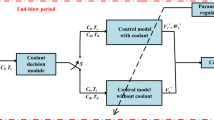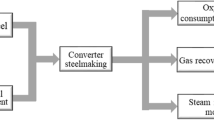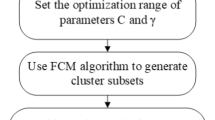Abstract
Basic oxygen furnace (BOF) steelmaking plays an important role in steelmaking process. Therefore, research on BOF steelmaking modeling is very necessary. In this paper, a novel combination prediction model has been proposed, which consists of a time series prediction model and a compensation prediction model. Both models are established by k-nearest neighbor-based weighted twin support vector regression (KNNWTSVR) algorithm. By introducing Lévy flight algorithm and inertia weight, an improved algorithm of whale optimization algorithm (WOA) called Lévy flight WOA has been initially proposed to solve the optimization problem in the objective function of KNNWTSVR. The simulation results show that the proposed models are effective and feasible. Within different error bounds (0.005% for carbon content model and 10 °C for temperature model), the strike rates of carbon content and temperature both achieve 93%, and a double strike rate of 86% is obtained, which can provide a significant reference for real BOF applications, and the proposed method is also appropriate for the prediction models of other metallurgical applications.







Similar content being viewed by others
References
Brämming M, Björkman B, and Samuelsson C, Steel Res Int 87 (2016) 301.
Wang Z, Xie F M, and Wang B, Steel Res Int 85 (2014) 599.
Han M, and Liu C, Appl Soft Comp 19 (2014) 430.
Wang X Z, Han M, and Wang J, Eng Appl Artif Intell 23 (2010) 1012.
Han M, and Cao Z J, Neurocomputing 149 (2015) 1245.
Kong L X, Hodgson P D, and Collinson D C, ISIJ Int 38 (1998) 1121.
Frattini Fileti A M, Pacianotto T A, and Pitasse Cunha A, Eng Appl Artif Intell 19 (2006) 9.
Jimenez J, Mochon J, and Ayala J S, ISIJ Int 44 (2004) 573.
Jayadeva, Khemchandani R, and Chandra S, IEEE Trans on Pattern Anal Machine Intell 29 (2007) 905.
Peng X, Neural Netw 23 (2010) 365.
Gupta D, Appl Intell 47 (2017) 1–30.
Xu Y and Wang L, Appl Intell 41 (2014) 299.
Rastogi R, Anand P, and Chandra S, Appl Intell 46 (2016) 1.
Xu Y, Li X, and Pan X, Neural Comp Appl 2 (2017) 1.
Ye Y F, Bai L, and Hua X Y, Neurocomputing 197 (2016) 53.
Tanveer M, Shubham K, and Aldhaifallah M, Appl Intell 44 (2016) 1.
Parastalooi N, Amiri A, and Aliheydari P, Neurocomputing 211 (2016) 84.
Khemchandani R, Goyal K, and Chandra S, Neural Netw 74 (2016) 14.
Peng X, Chen D, and Kong L, Int J Mach Learn Cyber 6 (2015) 719.
Tanveer M, and Shubham K, Int J Mach Learn Cyber 8 (2017) 807.
Khemchandani R, Karpatne A, and Chandra S, Int J Mach Learn Cyber 4 (2013) 51.
Mirjalili S, and Lewis A, Adv Eng Software 95 (2016) 51.
Kennedy J, and Eberhart R, IEEE International Conference on Neural Networks (1995) p 1942.
Marco D, Montes O M A, and Sabrina O, Comp Intell Mag IEEE 1 (2003) 28.
Pinto P C, Runkler T A, and Sousa J M C, International Conference on Adaptive and Natural Computing Algorithms (2007) pp 350–357.
Yang X S, Int J Bio-Inspired Comp 2 (2010) 78.
Pan W T, Knowledge-Based Syst 26 (2012) 69.
Gandomi A H, and Alavi A H, Commun Nonlinear Sci Numer Simul 17 (2012) 4831.
Askarzadeh A, and Rezazadeh A, Int J Energy Res 37 (2013) 1196.
Kaveh A, and Farhoudi N, Adv Eng Software 59 (2013) 53.
Mehrdad G, Zahra Z, and Yazdan A, Physicia A 388 (2009) 1509.
Yang X S, and Deb S, Int J Math Modelling Numer Opt 1 (2010) 330.
Shi Y, and Eberhart R, Proc. of IEEE ICEC conference (1998) p 69.
Acknowledgements
This work was supported by the National Natural Science Foundation of China under Grants 61403177.
Author information
Authors and Affiliations
Corresponding author
Rights and permissions
About this article
Cite this article
Gao, C., Shen, M., Liu, X. et al. End-point Prediction of BOF Steelmaking Based on KNNWTSVR and LWOA. Trans Indian Inst Met 72, 257–270 (2019). https://doi.org/10.1007/s12666-018-1479-5
Received:
Accepted:
Published:
Issue Date:
DOI: https://doi.org/10.1007/s12666-018-1479-5




